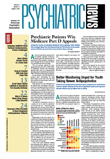This year's APA annual meeting in Toronto included candid discussions with a film star, sessions on the latest research and policy on alcohol use disorders, and symposia on a wide range of clinical issues.
These and other annual meeting sessions won high praise from attendees, according to a report by APA's Department of Continuing Medical Education (CME) prepared by Kathleen Debenham, M.A., director of that department.
According to the report, more than 90 percent of 4,962 respondents who completed the general evaluation agreed that the quality of the annual meeting sessions was excellent and met their educational objectives.
In addition, 89 percent agreed that meeting sessions incorporated current research.
About an equal number of evaluation respondents agreed that Toronto was an“ excellent” place for the meeting.
Approximately 18,400 people came to Toronto for the meeting. Of those, meeting registrants numbered 15,173; the remainder was made up of 3,207 exhibitors, press, and staff. The total is slightly ahead of that of the 2005 annual meeting in Atlanta (17,545).
APA members accounted for 5,591 (37 percent) of the registrants, 592 of whom were international members.
International attendance overall was 7,588, constituting about half of the total registration. The number of international attendees is second only to the 2004 meeting in New York. However, international attendance comprised a larger percentage of registrants in 2006, according to the report.
Excluding the 1,604 Canadian attendees, international attendance accounted for 39 percent of registrants.
After Canada, the largest number of international attendees came from Spain (594), followed by the Netherlands (451).
Scientific Program Receives High Marks
“Evaluation respondents gave high marks to the scientific program for meeting the needs of their clinical practices,” said Debenham.“ Nearly 60 percent anticipated that their practices would be enhanced by the content of the sessions, 30 percent reported validation of their practices, and another 4 percent plan to change their practices” based on the content of the sessions.
APA continued to use a variety of strategies to monitor industry-supported symposia (ISS) to ensure that the material presented was balanced and unbiased.
Since 1998 APA has used the ISS Resident Monitor Program for both the annual meeting and the Institute on Psychiatric Services, held in October.
Through that program psychiatry residents attend the ISS and, using guidelines developed by APA's Department of CME and Committee on Commercial Support, monitor the balance in each presentation, disclosure of conflicts of interest by faculty, use of generic versus brand names, discussion of unapproved or investigational uses, and bias toward the supporting-company's products.
The results of the evaluation of those symposia suggest that APA's oversight measures are effective, since an overwhelming majority of respondents (96 percent) agreed that “multiple viewpoints” and“ an unbiased view of the topic” were presented in the sessions. In addition, 98 percent thought that the ISS sessions were“ excellent.”
Approximately 86 percent of the respondents to the general evaluation survey identified themselves as psychiatrists, and about 3 percent of those respondents were residents.
Nonphysician health professionals made up a relatively small portion of the evaluation respondents: 1.4 percent were psychologists, 1 percent were nurses, and 0.5 percent were social workers.
In the section of the survey in which respondents were invited to write in comments, some praised the high quality of the meeting and the focus on cultural diversity.
More Interactive Sessions
Many attendees, hoping to build on successful experiences at the meeting, requested a greater number of interactive sessions for future meetings. The workshop format, in particular, lends itself to “give and take” between faculty and participants, Debenham noted.
About 82 percent of respondents indicated that they plan to attend next year's annual meeting, which will be held May 19 to 24 in San Diego.
The evaluation report was based on responses to the general evaluation survey form, which was available in two formats: a printed copy and online. The online site, which could be accessed during and after the meeting, allowed users to generate a personalized certificate of attendance upon completion of the survey. ▪
